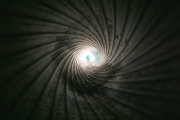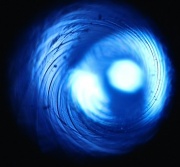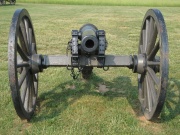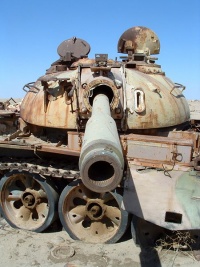Rifling
Rifling refers to helix-shaped pattern of grooves and lands that have been formed into the barrel of a firearm. It is the means by which a firearm imparts a spin to a projectile around its long axis, to gyroscopically stabilize it to improve accuracy and stability.
It also refers to the process of making the spiral grooves in the barrel of a gun or firearm, which imparts a spin to a projectile around its long axis. This spin serves to gyroscopically stabilize the projectile, improving its aerodynamic stability and accuracy.
Rifling is described by its twist rate, which indicates the distance the bullet must travel to complete one full revolution, such as "1 turn in 10 inches" (1:10 in.), or "1 turn in 30 cm" (1:30 cm). A shorter distance indicates a "faster" twist, meaning that for a given velocity the projectile will be rotating at a higher spin rate.
A combination of the weight, length and shape of the projectile determines the twist rate needed to stabilize it – barrels intended for short, large-diameter projectiles like spherical lead balls require a very low twist rate, such as 1 turn in 48" (122 cm).[1] Barrels intended for long, small-diameter bullets, such as the ultra-low-drag, 80-grain 0.223 inch bullets (5.2 g, 5.56 mm), use twist rates of 1 turn in 8 inches (20 cm) or faster.[2]
In some cases, rifling will have a twist rate that increases down the length of the barrel, called a gain twist or progressive twist; a twist rate that decreases from breech to muzzle is undesirable, as it cannot reliably stabilize the bullet as it travels down the bore.[3][4] Extremely long projectiles such as flechettes may require impractically high twist rates; these projectiles must be inherently stable, and are often fired from a smoothbore barrel.
Contents[hide] |
[edit] Twist rate
For best performance, the barrel should have a twist rate sufficient to stabilize any bullet that it would reasonably be expected to fire, but not significantly more. Large diameter bullets provide more stability, as the larger radius provides more gyroscopic inertia, while long bullets are harder to stabilize, as they tend to be very backheavy and the aerodynamic pressures have a longer "lever" to act on. The slowest twist rates are found in muzzleloading firearms meant to fire a round ball; these will have twist rates as low as 1 in 60 inches (1,500 mm), or slightly longer, although for a typical multi-purpose muzzleloader rifle, a twist rate of 1 in 48 inches (1,200 mm) is very common. The M16A2 rifle, which is designed to fire the SS109 bullet, has a 1 in 1 in 7-inch (180 mm) twist. Civilian AR-15 rifles are commonly found with 1 in 12 inches (300 mm) for older rifles and 1 in 9 inches (230 mm) for most newer rifles, although some are made with 1 in 7 inches (180 mm) twist rates, the same as used for the M16. Rifles, which generally fire longer, smaller diameter bullets, will in general have higher twist rates than handguns, which fire shorter, larger diameter bullets.
George Greenhill, a mathematician at Emmanuel College, Cambridge, UK, developed a rule of thumb for use in calculating twist rates for a given lead-core bullet. The formula, named the Greenhill Formula in his honour, is:
| Twist = | CD2 | x | ( | SG | ) | 1/2 |
| |
||||||
| L | 10.9 |
where:
- C = 150 (use 180 for muzzle velocities higher than 2,800 f/s)
- D = bullet's diameter in inches
- L = bullet's length in inches
- SG = bullet's specific gravity (10.9 for lead-core bullets, which cancels out the second half of the equation)
The original value of C was 150, which yields a twist rate in inches per turn, when given the diameter D and the length L of the bullet in inches. This works to velocities of about 2800 ft/s; above those velocities, a C of 180 should be used. For instance, with a velocity of 2000 ft/s, a diameter of 0.5 inches (13 mm) and a length of 1.5 inches (38 mm), the Greenhill formula would give a value of 30, which means 1 turn in 30 inches (760 mm).
If an insufficient twist rate is used, the bullet will begin to yaw and then tumble; this is usually seen as "keyholing", where bullets leave elongated holes in the target as they strike at an angle. Once the bullet starts to yaw, any hope of accuracy is lost, as the bullet will begin to veer off in random directions as it precesses.
Conversely, too-high a rate of twist can also cause problems. The excessive twist can cause accelerated barrel wear, and in high velocity bullets, an excessive twist can cause a very high spin rate in excess of the bullet's burst speed (via centripetal force). A higher twist than needed can also cause more subtle problems with accuracy: Any inconsistency in the bullet, such as a void that causes an unequal distribution of mass, may be magnified by the spin. Undersized bullets also have problems, as they may not enter the rifling exactly concentric and coaxial to the bore, and excess twist will exacerbate the accuracy problems this causes. Lastly, excessive spinning causes a reduction in the lateral kinetic energy of a projectile, thereby reducing its destructive power (the energy instead becomes rotational kinetic energy).
[edit] Manufacture
Most rifling is created by either:
- cutting one groove at a time with a machine tool, called cut rifling or single point cut rifling
- cutting all grooves in one pass with a special progressive broaching bit, called broached rifling
- pressing all grooves at once with a tool called a "button" that is pushed or pulled down the barrel, called button rifling
- forging the barrel over a mandrel containing a reverse image of the rifling (and often the chamber as well), called hammer forged
- flow forming the barrel preform over a mandrel containing a reverse image of the rifling, called rifling by flow forming. A new developed method by MACDOR company Turkey.
The grooves are the spaces that are cut out, and the resulting ridges are called 'lands'. These lands and grooves can vary in number, depth, shape, direction of twist ('right' or 'left'), and 'twist rate' (turns per unit of barrel length). The spin imparted by rifling significantly improves the stability of the projectile, improving both range and accuracy. Typically rifling is a constant rate down the barrel, usually measured by the length of travel required to produce a single turn. Occasionally firearms are encountered with a gain twist, where the rate of spin increases from chamber to muzzle. While intentional gain twists are rare, due to manufacturing variance, a slight gain twist is in fact fairly common. Since a reduction in twist rate is very detrimental to accuracy, gunsmiths who are machining a new barrel from a rifled blank will often measure the twist carefully so they may put the faster rate, no matter how minute the difference is, at the muzzle end (see internal ballistics for more information on accuracy and bore characteristics).
Typically in modern, smokeless powder, small firearms, the diameter of the bullet matches the diameter of the circle that encompasses the bottoms of the rifled grooves, the groove diameter. The bore diameter is smaller, being measured across the tops of the lands. When the cartridge is fired, the bullet is forced into the barrel and the rifling engages the bullet, engraving it with an impression of the rifling. As the bullet is propelled down the barrel, it begins to spin. This rate of spin is dictated by a bullet's muzzle velocity and the twist rate of the rifling. As mentioned earlier, for a given caliber, faster rates of twist are needed to stabilize longer bullets.
In contrast, in modern, black powder, small firearms that utilize patched bullets, the diameter of the bullet is usually chosen to be slightly smaller than this, being typically 0.015 inches in diameter less than the diameter of the circle that encompasses the bottoms of the rifled grooves. This is done to permit using a patch that may be, say, 0.010 inches thick, nominal, uncompressed. Folded over the bullet, the nominally 0.010 inch thick patch will then compress from 0.020 inches (accounting for the two thicknesses of the patch) down to 0.015 inches, thereby forming a tight fit of the bullet with the rifling.
The diameters of bullets fired from a rifled barrel should ideally be at or slightly under the groove diameter, for the reasons as previously discussed, but should definitely be larger than the bore diameter. A bullet that is too large will have to swage down to fit in the bore, which can cause excessive and potentially unsafe pressures, as well as causing bullet irregularities to form that may affect accuracy, while a bullet that is too small will lose velocity and either leak gas or obturate at an angle, likewise providing poor accuracy.
[edit] History
The history of rifling a barrel is covered in depth in the article Rifle.
[edit] Recent developments
The grooves most commonly used in modern rifling have fairly sharp edges. More recently, polygonal rifling, a throwback to the earliest types of rifling, has become popular, especially in handguns. Polygonal barrels tend to have longer service lives because the reduction of the sharp edges of the land reduces erosion of the barrel. Supporters of polygonal rifling also claim higher velocities and greater accuracy. Polygonal rifling is currently seen on pistols from Heckler & Koch, Glock and Kahr Arms, as well as the Desert Eagle.
For tanks and artillery pieces, the extended range, full bore concept developed by Gerald Bull for the GC-45 howitzer reverses the normal rifling idea by using a shell with small fins that ride in the grooves, as opposed to using a slightly oversized projectile which is forced into the grooves. Such guns have achieved significant increases in muzzle velocity and range. Examples include the South African G5 howitzer and the German PzH 2000.
[edit] See also
[edit] External links
- Article on barrel making from an IHMSA shooter
- Rifling By Flow Forming A new developed method for rifling.
- Article on barrel making from Lilja, a maker of world class competition barrels
- Article on making and measuring rifling by Lilja; includes pictures of button rifling machine
- 6mmBR article on barrels
- Bore slugging tutorial, explaining now to determine the true bore and groove size and choose appropriate bullet diameters
Cite error: <ref> tags exist, but no <references/> tag was found



